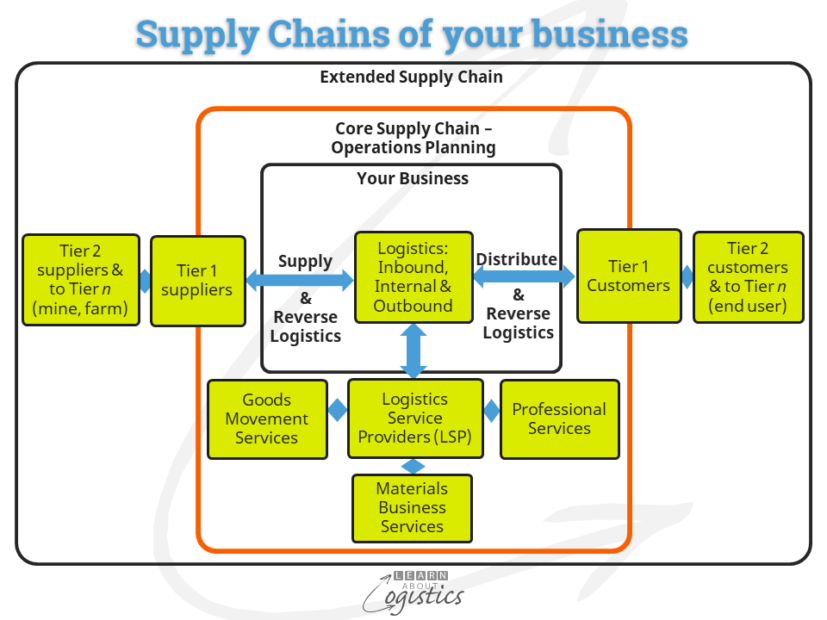Established facts in supply chains
Like a watch mechanism, Supply Chains have many moving parts. It works when all the parts are in place and responding to each movement. But, take out one cog and the whole mechanism is in trouble. This has been demonstrated throughout the COVID-19 pandemic.
For some companies, getting to ‘Lean’ (incorporating the ‘just in time’ inventory process) has been a single minded objective. But when COVID-19 arrived, there was no inventory to cover shortfalls in supplies or output. Maybe these companies did not understand the objective of Lean (which emulates the Toyota Production System) is to reduce waste – the ‘just in time’ inventory process is an outcome, not the initial aim.
Tight supply chains provide the unwelcome feature of Lead Time Syndrome (LTS). A sudden (and maybe ‘one-off’) ‘spike’ in demand causes an imbalance between demand and supply for a group of items in an industry sector. Without any slack in a supply chain, a sudden increase in end user demand will result in increased lead times from suppliers; this requires an increased order size, which increases lead times and so on.
The situation is only corrected when more capacity is provided – suppliers are able to work additional hours or acquire new factories, trucks, ships etc. If capacity cannot be increased, it takes time for the supply chains of a sector to rebalance. The Syndrome is currently illustrated with the ‘spike’ in consumer demand for household durables and vehicles in developed countries.
Current examples of LTS
In the case of household durables, a recent McKinsey video presentation provides an overview of the constraints in supply that has caused disruption to container services for household durables. In the automotive industry, semi-conductor capacity available for automotive use was reduced when vehicle assemblers lowered orders in early 2020, due to an expected drop in demand. However, consumer demand increased, resulting in large orders on the semiconductor manufacturers, but capacity had been re-allocated for the electronics industry.
In both situations, demand will ease as consumer’s homes are filled with purchases and cross-border vacations and entertainment restart. As vaccinations of port staff increase, the absentee rate should decrease, so capacity increases. Shipping companies are ordering additional containers and new (and larger) ships; to commence service in 2023/4. For the automotive industry to regain the required capacity for semi-conductor designs that are ‘automotive dedicated’ could increase supply risks. Therefore, automotive companies may have to share construction costs or acquire their own facilities.
Supply Chains of your business
Directors and senior executives are often not aware of facts about supply chains – ‘Just in Time’ inventory (plus Lean) and the Lead Time Syndrome were identified at least 40 years ago. It would be nice for senior management to appreciate the value of supply chains – due to the pandemic, the true costs of supply chains are evident!
To reduce supply chain risks and improve operational performance means that parts of the organisation work collaboratively. This objective requires that management and staff have an understanding of your organisation’s supply chains and how they influence the business. This requires staff to not only know the ‘how’ of their tasks but ‘why’.

Viewing the diagram, Supply Chains consist of ‘activity nodes’ and ‘movement links’ at each stage through a core (to tier 1 suppliers and customers) and extended supply chain. Because they consist of independent entities, Supply Chains cannot be ‘managed’. Instead, the ‘management’ in SCM is managing risks and business relationships with suppliers and customers, in the process of planning, sourcing, storing and moving items.
The role of Logistics is to provide Availability (of materials, components or products (with any associated services). For the item to be available requires Operations Planning to plan and schedule resources and flows (of items, money, transactions and information) and Procurement to source input items. Provide Availability is guided by some principles:
- Supply Chains of an organisation are a network of independent, but inter-dependent organisations
- An increasing reliance for achieving Availability by shippers is placed on 3PL distribution and transport businesses
- Few (if any) suppliers are dependent on your organisation’s business. To ensure Availability requires interaction with suppliers through people and technologies
- The network interacts within a complex, adaptable system (CAS) that has no central control mechanism
- Improved performance of your Supply Chains depends on the knowledge and capability of people across your organisation’s functional boundaries and with 3PLs and other Logistics Services Providers (LSPs)
The global nature of Supply Chain Networks has increased Uncertainty – in supply markets, at suppliers and contractors and within customers and their markets; at end users and internally. Uncertainty is the unstructured opinions in your organisation about supply chains. These opinions are influenced by:
- Complexity: built into processes, both internal (often management directed) and external, which is influenced by:
- Breadth: number of direct Tier 1 suppliers in the supply base
- Depth: number of Tiers of suppliers in each supply chain
- Geography: global spread (therefore distance) from the organisation to its customers and suppliers
- Variability: in patterns of demand and supply through the supply chains, at locations and at individual machines in the organisation’s facilities
- Constraints: restrictions and interruptions in the flows of items, money, transactions and information moving through supply chains
- Focus within the organisation’s operations on speed and efficiency rather than effectiveness
- Safety margins concerning time, inventory and working capital
- Non-linear flows – many ‘ifs’ and ‘thens’ as in a Decision Tree diagram
- Emergent and Cumulative outcomes, over which an organisation’s management has little control
A role of the supply chains group is to convert Uncertainty into structured Risks that can be measured and managed. However, because supply chains do not respect the functional barriers of your organisation, understanding supply chains is not the sole responsibility of Logisticians.
An approach is for the ‘why’ of Supply Chains, Procurement, Operations Planning and Logistics to be acquired through online learning. The learning is then applied in cross function groups that meet (or teleconference) to work on simulations and case study scenarios. The group work can be augmented with teleconferencing to debate application of the concepts to the business.
An in-depth understanding of specific areas concerning supply chains can be obtained through short courses at universities and colleges. However, they are less equipped for providing companies with cross-function learning about risks and relationships in an organisation’s supply chains. This is an opportunity for 3PL businesses to provide an additional service for their clients.

